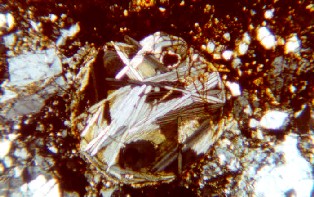 Hughes 021
Hughes 021How to recognize a meteorite?
People often distinguish meteorites from terrestrial rocks by following properties:
To check the meteoritic nature of such rocks, various investigations are necessary. The results mostly reject an extraterrestrial source and confirm an atrificial or natural terrestrial material.
Laboratory investigation at BML! (Bartoschewitz.Meteorite-Lab@t-online.de)
Details are in German language available
Why meteorites are so important for science?
Meteorites are natural extraterrestrial rocks. Each meteorite is an unique object carrying information about a wide variety of solar-system processes. So a sample of every meteorite must be available for scientific investigations!
With some exceptions meteorites were formed from the pre-solar nebular together with our solar-system about 4.5 billion years ago. So meteorites are the oldest for us available material.
Since the formation of the solar system a lot of these cosmic rocks are hardly transformed. So they are primary material of our solar system.
During their space odyssee they were exposed to cosmo-galactic rays. Information about those cosmo-galactic ray influences are saved in meteorites.
Most of the meteorites are from the Asteroid Belt between Mars and Jupiter, some few are from the Earth's moon and probably also from the planet Mars.
Some meteorites contain amino acids. These "organic" pre-stage of our proteines were formed in interplanetary space by anorganic chemical reactions. Were those amino acids perhaps the first step for life on our planet and could not they have formed any other kind of life on other cosmic bodies?
In 3 meteorites, which are probably from Mars, were found inclusions, which remind to micro-fossils. Perhaps these are traces for life on the planet Mars.
Giant meteorites and asteroides impacted the Earth and left craters. These impacts initiated also hughe environmental catastrophes, that contributed to the extinction of sensitive kinds of life, for example the dinosaures 65 million years ago.
Meteorites do not bear new chemical elements, but minerals, that are natural formed unknown from Earth .
Meteoritic rock structures give information about the formation conditions in the early solar system, and show parallels to the formation of planet cores, too.
The hughe number of meteorite finds in Antarctica gave important information about glacier movements.
 Hughes 021
Hughes 021
HOME | Collections | Research | German Meteorites
Deutsches Meteoriten Kolloquium | Deutscher Meteoriten Weg | ENDeuMet